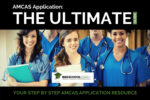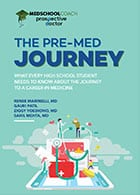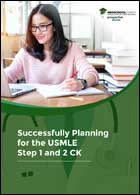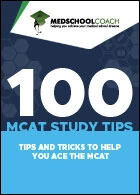
Table of Contents
The personal statement is one of the most important parts of the med school application process because this mini-essay is a critical opportunity for you to stand out from other prospective medical students by demonstrating your passion and personality, not just your grades.
Admissions committees receive hundreds or more AMCAS medical school applications, so yours should be unique and captivating. Your medical school personal statement shows admissions officers who you are beyond your high school or pre-med GPA, extracurriculars, and MCAT score.
The best personal statements are… well, personal. This is your chance to share what life experiences have compelled you toward a career in healthcare or the medical field, and how those experiences shape the picture of your ideal future.
MedSchoolCoach has crucial advice for writing your personal statement.
Read these examples of personal statements for prospective med students.
Writing a great medical school personal statement is a lot easier with the right support. We’ve helped numerous med school applicants craft top-notch personal statements and can do the same for you.
But First: 7 Steps to Writing an Engaging Personal Statement
Before you read these excellent examples, you need to understand the process of writing a personal statement.
Include these in your medical school personal statement:
- Why you’re passionate about becoming a doctor
- Your qualities that will make you a great physician
- Personal stories that demonstrate those qualities
- Specific examples of the communities you want to serve as a member of the medical field
What are the most important things to remember when writing a medical school personal statement?
- Begin the writing process early: Give yourself plenty of time for brainstorming and to revisit your first draft, revising it based on input from family members and undergrad professors. Consult the application timeline for your target enrollment season.
- Choose a central theme: An unfocused essay will leave readers confused and uninterested. Give your statement a clear thesis in the first paragraph that guides its formation.
- Start with a hook: Grab the reader’s attention immediately with your statement’s first sentence. Instead of opening with a conventional introduction, be creative! Begin with something unexpected.
- Be the you of today, not the you of the future: Forecasting your future as a physician can come across as empty promises. Don’t get caught up in your ambitions; instead, be honest about your current situation and interest in the field of medicine.
- Demonstrate your passion: It’s not enough to simply state your interest in becoming a doctor; you have to prove it through personal stories. Show how your perspectives have been shaped by formative experiences and how those will make you an effective physician.
- Show, don’t tell: Avoid cliches that admissions committees have heard hundreds of times, like “I want to help people.” Make your writing come alive with dynamic, persuasive storytelling that recounts your personal experiences.
- Tie everything together: Conclude by wrapping up your main points. Reiterate your passion for the medical profession, your defining personal qualities, and why you’ll make a good doctor.
You can read more about our recommended method in our step-by-step guide, but those are the major points.
Example 1 — From the Stretcher to the Spotlight: My Journey to Becoming an Emergency Medicine Physician
Another siren shrieks as the emergency room doors slide open and a team of EMTs pushes a blood-soaked stretcher through the entrance. It’s the fifth ambulance to arrive tonight — and only my first clinical shadowing experience in an emergency medicine department since my premed education began.
But it wasn’t my first time in an emergency room, and I knew I was meant to be here again.
In those crucial moments on the ER floor, many of my peers learned that they stumble in high-pressure environments. A few weeks of gunshot wounds, drug overdoses, broken bones, and deep lacerations in the busiest trauma bay in the region were enough to alter their career path.
They will be better practitioners somewhere predictable, like a pediatrician in a private practice where they choose their schedules, clients, and staff.
Every healthcare provider has their specialties, and mine are on full display in those crucial moments of lifesaving care. Why am I pursuing a career in Emergency Medicine? Because I’ve seen firsthand the miracles that Emergency Medicine physicians perform.
12 years ago, I was in an emergency room… but I was the one on the stretcher.
A forest-green Saturn coupe rolled into my parent’s driveway. The driver, my best friend Kevin, had just passed his driving test and was itching to take a late-night run to the other side of town. I had ridden with Kevin and his father many times before when he held his learner’s permit. But this time, we didn’t have an adult with us, and the joyride ended differently: with a 40-mph passenger-side collision, T-boned by a drunk driver.
I distinctly recall the sensation of being lifted out of the crumpled car by a paramedic and laid onto a stretcher. A quick drive later, I was in the care of Dr. Smith, the ER resident on call that night. Without missing a beat, he assessed my condition and provided the care I needed. When my mom thanked him for saving my life, he simply responded, “It’s what he needed.”
Now I’m watching other doctors and nurses provide this life-saving care as I observe as a premed student. I see the way the staff works together like a well-oiled machine, and it reminds me of my time in high-school theater.
Everyone has a role to play, however big or small, to make the show a success. All contributions are essential to a winning performance — even the technicians working behind the scenes. That’s what true teamwork is, and I see that same dynamic in the emergency department.
Some actors freeze during performances, overcome by stage fright. Other students are too anxious to even set foot in front of an audience; they remain backstage assisting with split-second costume changes.
Not me. I felt energized under the spotlight, deftly improvising to help my co-stars when they would forget their lines. Admittedly, I wasn’t the best actor or singer in the cast, but I provided something essential: assurance under pressure. Everyone knew me as dependable, always in their corner when something went awry. I had a reputation for remaining calm and thinking on my feet.
My ability to stay unruffled under pressure was first discovered on stage, but I can use it on a very different platform providing patient care. Now, when other people freeze under the intensity of serving public health on the front lines, I can step in and provide my calm, collected guidance to see them through.
As an ER doctor, I will have to provide that stability when a nurse gets flustered by a quarrelsome patient or shaken from an irreparably injured infant. When you’re an Emergency Medicine physician, you’re not following a script. It takes an aptitude of thinking on your toes to face the fast pace and unpredictable challenges of an emergency center.
During my time shadowing, I saw experienced physicians put those assured, gentle communication skills to use. A 13-year-old boy was admitted for a knife wound he’d received on the streets. He only spoke Spanish, but it was clear he mistrusted doctors and was alarmed by the situation. In mere minutes, one of the doctors calmed the patient so he could receive care he needed.
Let me be clear: I haven’t simply gravitated toward Emergency Medicine because I liked it most. It’s not the adrenaline or the pride that compel me. I owe Emergency Medicine my life, and I want to use my life to extend the lives of other people. Every person brought into the trauma bay could be another me, no matter what they look like.
People are more than their injury, health record, or circumstances. They are not just a task to complete or a challenge to conquer.
My childhood injury gave me an appreciation for the work of ER doctors and a compassion for patients, to foster well-being when people are most broken and vulnerable. I already have the dedication to the work and the heart for patients; I just need the medical knowledge and procedural skills to perform life-saving interventions. My ability to remain calm, think on my toes, be part of a team, and work decisively without making mistakes or overlooking critical issues will serve me well as an Emergency Medicine physician.
Some ER physicians I spoke with liked to think that they’re “a different breed” than other medical professionals — but I don’t see it that way. We’re just performing a different role than the rest of the cast.
Breaking It Down
Let’s look at what qualities make this a great personal statement for med school.
- Engaging opening: The writer painted a vivid scene that immediately puts the reader in their shoes and leaves them wanting more.
- Personal examples: The writer demonstrated his ability to stay calm, work as a team, and problem-solve through theater experience, which he also uses as a comparison. And, he explained his passion for Emergency Medical care from his childhood accident.
- Organized: The writer transitions fluidly between body paragraphs, connecting stories and ideas by emphasizing parallels and hopping back and forth between time.
- Ample length: Makes full use of the AACOMAS and AMCAS application personal statement’s character limit of 5,300 characters (including spaces), which is about 850-950 words.
Unsure what traits and clinical or research experience your preferred medical school values? You can research their admissions requirements and mission statement using the MSAR.
Example 2 — Early Clinical Work For Empathetic Patient Care
The applicant who wrote this personal statement was accepted into University of South Florida Morsani College of Medicine, University of Central Florida College of Medicine, and Tufts University School of Medicine.
As I walked briskly down the hall to keep up during our daily rounds in the ICU, I heard the steady beeping of Michelle’s cardiac monitor and saw a ruby ornament twinkling on the small Christmas tree beside her. She was always alone, but someone had decorated her room for the holidays.
It warmed my heart that I wasn’t the only one who saw her as more than a patient in a coma. I continually felt guilty that I couldn’t spend more time with her; her usual companions were ventilators, IV bags, and catheters, not to mention the golf ball-sized tumors along her spine. Every day, I thought about running to Michelle’s bedside to do anything I could for her.
Thus, I was taken aback when my advisor, who was visiting me that day, asked me if I was okay. It never crossed my mind that at age 17, my peers might not be able to handle the tragedies that healthcare workers consistently face. These situations were difficult, but they invoked humanity and compassion from me. I knew I wanted to pursue medicine. And I knew I could do it.
From my senior year of high school to my senior year of college, I continued to explore my passion for patient interaction.
At the Stepp Lab, I was charged with contacting potential study participants for a study focusing on speech symptoms in individuals with Parkinson’s Disease. The study would help future patients, but I couldn’t help but think: “What are we doing for these patients in return?” I worried that the heart and soul behind the research would get lost in the mix of acoustic data and participant ID numbers.
But my fears were put to rest by Richard, the self-proclaimed “Parkinson’s Song & Dance Man,” who recorded himself singing show tunes as part of his therapy. Knowing that he was legally blind and unable to read caller ID, I was always thrilled when he recognized my voice. The spirit in his voice indicated that my interest in him and his journey with Parkinson’s was meaningful. Talking with him inspired me to dive deeper, which led to an appreciative understanding of his time as a sergeant in the U.S. military.
It was an important reminder: my interest and care are just as important as an effective prescribed treatment plan.
Following graduation, I began my work as a medical assistant for a dermatologist. My experience with a patient, Joann, validated my ability to provide excellent hands-on patient care. Other physicians prescribed her painkillers to relieve the excruciating pain from the shingles rash, which presented as a fiery trail of blisters wrapped around her torso. But these painkillers offered no relief and made her so drowsy that she fell one night on the way to the bathroom.
Joann was tired, suffering, and beaten down. The lidocaine patches we initially prescribed would be a much safer option, but I refused for her to pay $250, as she was on the brink of losing her job. When she returned to the office a week later, she held my hand and cried tears of joy because I found her affordable patches, which helped her pain without the systemic effects.
The joy that pierced through the weariness in her eyes immediately confirmed that direct patient care like this was what I was meant to do. As I passed her a tissue, I felt ecstatic that I could make such a difference, and I sought to do more.
Since graduation, I have been volunteering at Open Door, a small pantry that serves a primarily Hispanic community of lower socioeconomic families. It is gut-wrenching to explain that we cannot give them certain items when our stock is low. After all, the fresh fruits and vegetables I serve are fundamental to their culturally-inspired meals.
For the first time, I found myself serving anguish rather than a helping hand. Usually, uplifting moments strengthen one’s desire to become a physician, but in this case, it was my ability to handle the low points that reignited my passion for aiding others.
After running out of produce one day, I was confused as to why a woman thanked me. Through translation by a fellow volunteer, I learned it was because of my positivity. She taught me that the way I approach unfavorable situations affects another’s perception and that my spirited attitude breaks through language barriers.
This volunteer work served as a wake-up call to the unacceptable fact that U.S. citizens’ health suffers due to lack of access to healthy foods. If someone cannot afford healthy foods, they may not have access to healthcare. In the future, I want to partner with other food banks to offer free services like blood pressure readings. I have always wanted to help people, but I now have a particular interest in bringing help to people who cannot afford it.
While the foundation of medicine is scientific knowledge, the foundation of healthcare is the word “care” itself. I never found out what happened to Michelle and her Christmas tree, but I still wonder about her to this day, and she has strengthened my passion to serve others. A sense of excitement and comfort stems from knowing that I will be there for people on their worst days, since I have already seen the impact my support has had.
In my mind, becoming a physician is not a choice but a natural next step to continue bringing humanity and compassion to those around me.
Breaking It Down
How did this personal statement grab and sustain attention so well?
- Personalization: Everything about this statement helps you to understand the writer, from their personal experiences to their hope for how their future career will look.
- Showing, not telling: From the first sentence, the reader is hooked. This prospective medical student has plenty of great “on paper” experience (early shadowing, clinical experience, etc.), but they showed this with storytelling, not by repeating their CV.
- Empathy: An admissions committee reading this personal statement would know beyond a shadow of a doubt that this student cares deeply about their patients. They remember first names, individual details, and the emotions that each patient made them feel.
- A clear path forward: The writer doesn’t just want to work in the medical field — they have a passion for exactly how they want to impact the communities they serve. Outside of strictly medical work, they care about the way finances can limit access to healthcare and the struggle to find healthy food in food deserts around the US.
Read Next: How Hard Is It to Get Into Medical School?
Example 3 — Beyond the Diagnosis: The Importance of Individualized Care in Medicine
The applicant who wrote this personal statement was accepted into Touro College of Osteopathic Medicine and Nova Southeastern University College Of Osteopathic Medicine.
Dr. Haywood sighs and shakes her head upon opening the chart. “I was worried about her A1C. It’s up again. Hypertension, too. Alright, let’s go.”
As we enter the patient’s room, I’m expecting the news about her blood sugar and pressure to fill the room. Instead, Dr. Haywood says, “Roseline! How are you doing? How’s your girl, doing well?”
Dr. Haywood continues to ask questions, genuinely interested in Roseline’s experience as a new mother. If not for the parchment-lined examination chair and anatomy posters plastered to the wall, this exchange could be happening in a grocery store. What about her A1C? Her blood pressure? Potential Type II diabetes?
As I continue to listen, Dr. Haywood discovers that Roseline’s mother moved in with her, cooking Haitian meals I recognize as high on the glycemic index. Dr. Haywood effortlessly evolves their conversation to focus on these. Being Haitian herself, she knows some traditional dishes are healthier than others and advises Roseline to avoid those that might exacerbate her high blood sugar and blood pressure. Dr. Haywood also suggests Roseline incorporate exercise by bringing her baby on a walk through her neighborhood.
During my shadowing experience, I observed one of the core components of being a physician through several encounters like this one. By establishing a relationship with her patient where Roseline was comfortable sharing the details of new motherhood, Dr. Haywood was able to individualize her approach to lowering the patient’s A1C and hypertension. Inspired by her ability to treat the whole person, I began to adopt a similar practice as a tutor for elementary kids in underserved areas of D.C.
Shaniyah did not like Zoom, or math for that matter. When I first met her as a prospective tutee online, she preferred to keep her microphone muted and would claim she was finished with her math homework after barely attempting the first problem. Realizing that basing our sessions solely on math would be fruitless, I adapted my tutoring style to incorporate some of the things for which she had a natural affinity.
The first step was acknowledging the difficulties a virtual environment posed to effective communication, particularly the ease at which distractions might take over. After sharing this with Shaniyah, she immediately disclosed her struggles to share her work with me. With this information, I found an online platform that allowed us to visualize each other’s work.
This obstacle in communication overcome, Shaniyah felt more comfortable sharing details about herself that I utilized as her tutor. Her love of soccer gave me the idea to use the concept of goal scoring to help with addition, and soon Shaniyah’s math skills and enthusiasm began to improve. As our relationship grew, so did her successes, and I suspect the feelings I experienced as her tutor are the same as a physician’s when their patient responds well to prescribed treatment.
I believe this skill, caring for someone as a whole person, that I have learned and practiced through shadowing and tutoring is the central tenet of medicine that allows a doctor to successfully treat their patients.
Inspired by talking with patients who had received life-altering organ transplants during my shadowing experience, I created a club called D.C. Donors for Georgetown University students to encourage their peers to register as organ donors or donate blood. This experience taught me that to truly serve a person, you must involve your whole person, too.
In starting this club to help those in need of transplants, I had to dedicate my time and effort beyond just my physical interactions with these patients. For instance, this involved reaching out to D.C.’s organ procurement organization to inquire about a potential partnership with my club, to which they agreed. In addition, I organized tabling events on campus, which required significant planning and communication with both club members and my university.
Though exciting, starting a club was also a difficult process, especially given the limitations the pandemic imposed on in-person meetings and events. To adapt, I had to plan more engaging meetings, designing virtual activities to make members more comfortable contributing their ideas. In addition, planning a blood drive required extensive communication with my university to ensure the safety of the staff and participants during the pandemic.
Ultimately, I believe these behind-the-scenes actions were instrumental in addressing the need for organ and blood donors in the D.C. area.
From these experiences, I have grown to believe that good medicine not only necessitates the physician cares for her patient as a whole, but also that she fully commits her whole person to the care of the patient. Tutoring and starting D.C. Donors not only allowed me to develop these skills but also to experience such fulfilling emotions: the pride I had in Shaniyah when her math improved, the gratefulness I felt when she confided in me, the steadfast commitment I expressed to transplant patients, and the joy I had in collaborating with other passionate club members.
I envision a career as a physician to demand these skills of me and more, and I have confirmed my desire to become one after feeling so enriched by practicing them.
Breaking It Down
Here’s what makes this personal statement such a good example of what works:
- Desirable qualities: The student clearly demonstrates qualities any school would want in an applicant: teachability, adaptability, leadership, organization, and empathy, to name a few. This again uses the “show, don’t tell” method, allowing the readers to understand the student without hand-holding.
- Personalized storytelling: Many in the healthcare profession will connect with experiences like the ones expressed here, such as addressing patient concerns relationally or the lack of blood donors during the recent pandemic. The writer automatically makes a personal link between themselves and the admissions committees reading this statement.
- Extensive (but not too long): Without feeling too wordy, this personal statement uses nearly all of the 5,300 characters allowed on the AMCAS application. There’s no fluff left in the final draft, only what matters.
Avoid These Common Mistakes
You can learn a lot from those personal statements. They avoid the most common mistakes that med school applicants make when writing the medical school personal statement.
Here are some things you should avoid in your personal statement if you want to be a doctor:
- Name-dropping: Admissions counselors won’t be impressed when you brag about your highly regarded family members, associates, or mentors. You need to stand on your own feet — not someone else’s.
- Dishonesty: Lies and exaggerations can torpedo your application. And they’re bad habits for anyone entering the medical field. Don’t do it.
- Unedited AI content: Artificial intelligence can help you edit and improve your writing, but don’t let it do the work for you. Your statement needs to be authentic, which means in your voice! A chatbot can’t feel or adequately convey your own empathy, compassion, trauma, drive, or personality.
- Grammatical errors and typos: Have someone reliable proofread your essay and scour it for typos, misspellings, and punctuation errors. Even free grammar-checking apps can catch mistakes!
- Telling without showing: I’ll reiterate how important it is to prove your self-descriptive statements with real-life examples. Telling without showing won’t persuade readers.
- Too many examples: Have 3-4 solid personal stories at most; only include a few that are crucial for providing your points. The more experiences you share, the less impact they’ll make.
- Fluff and filler: Cut all fluff, filler words, and irrelevant points. There are many other places you can include information in your application, such as secondary essays on your clinical experience, volunteer work, and research projects.
You can find more valuable do’s and don’ts in our in-depth guide to writing your best personal statement.
Need extra help? We’ve got you covered.
Schedule a meeting with MedSchoolCoach for expert support on writing and editing your personal statement. We’re here to help you impress medical school admissions committees!
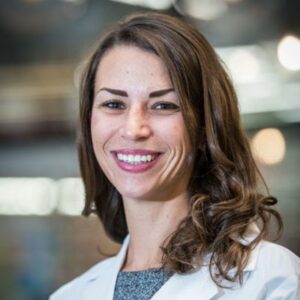
Renee Marinelli, MD
Dr. Marinelli has practiced family medicine, served on the University of California Admissions Committee, and has helped hundreds of students get into medical school. She spearheads a team of physician advisors who guide MedSchoolCoach students.

